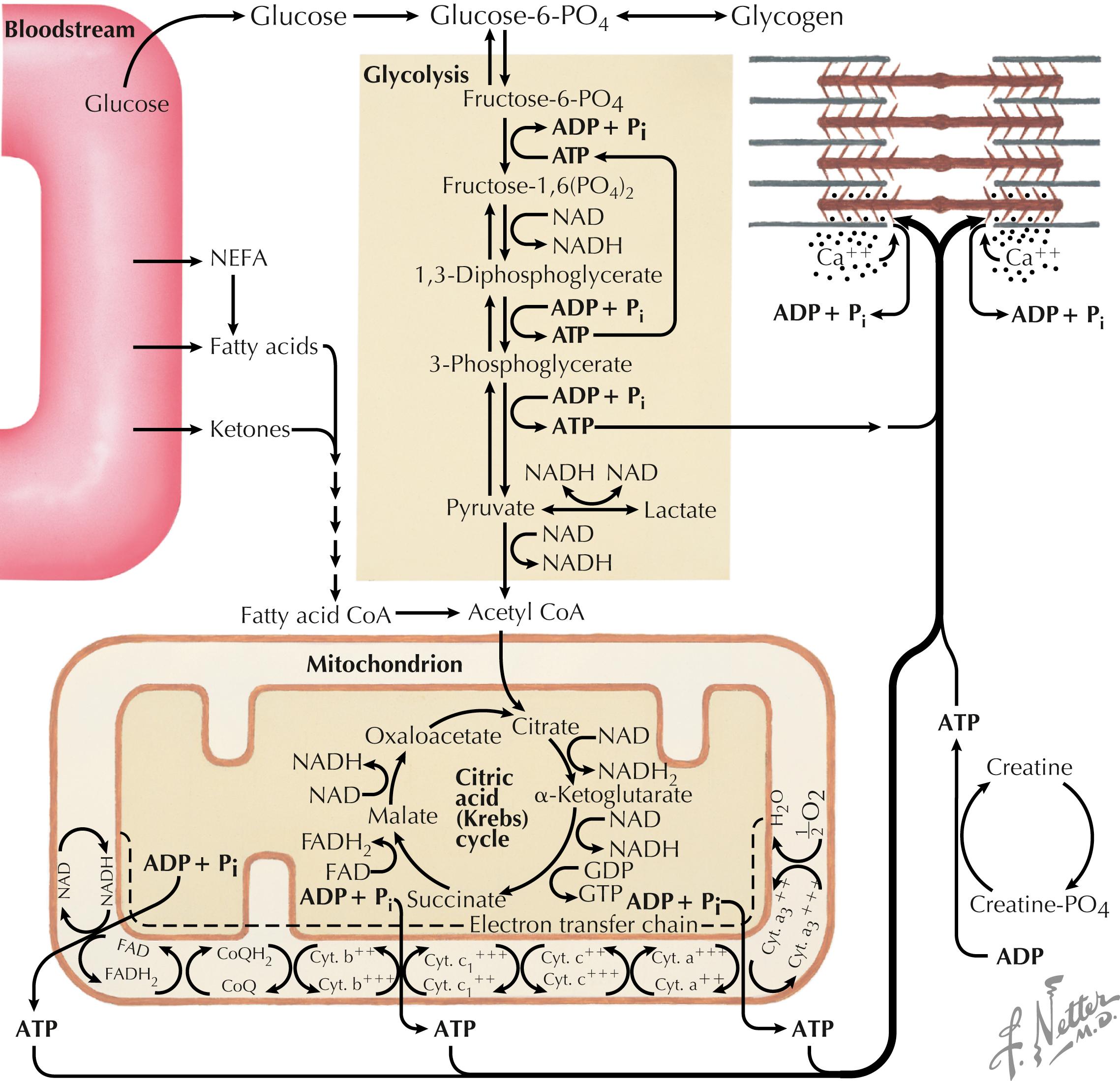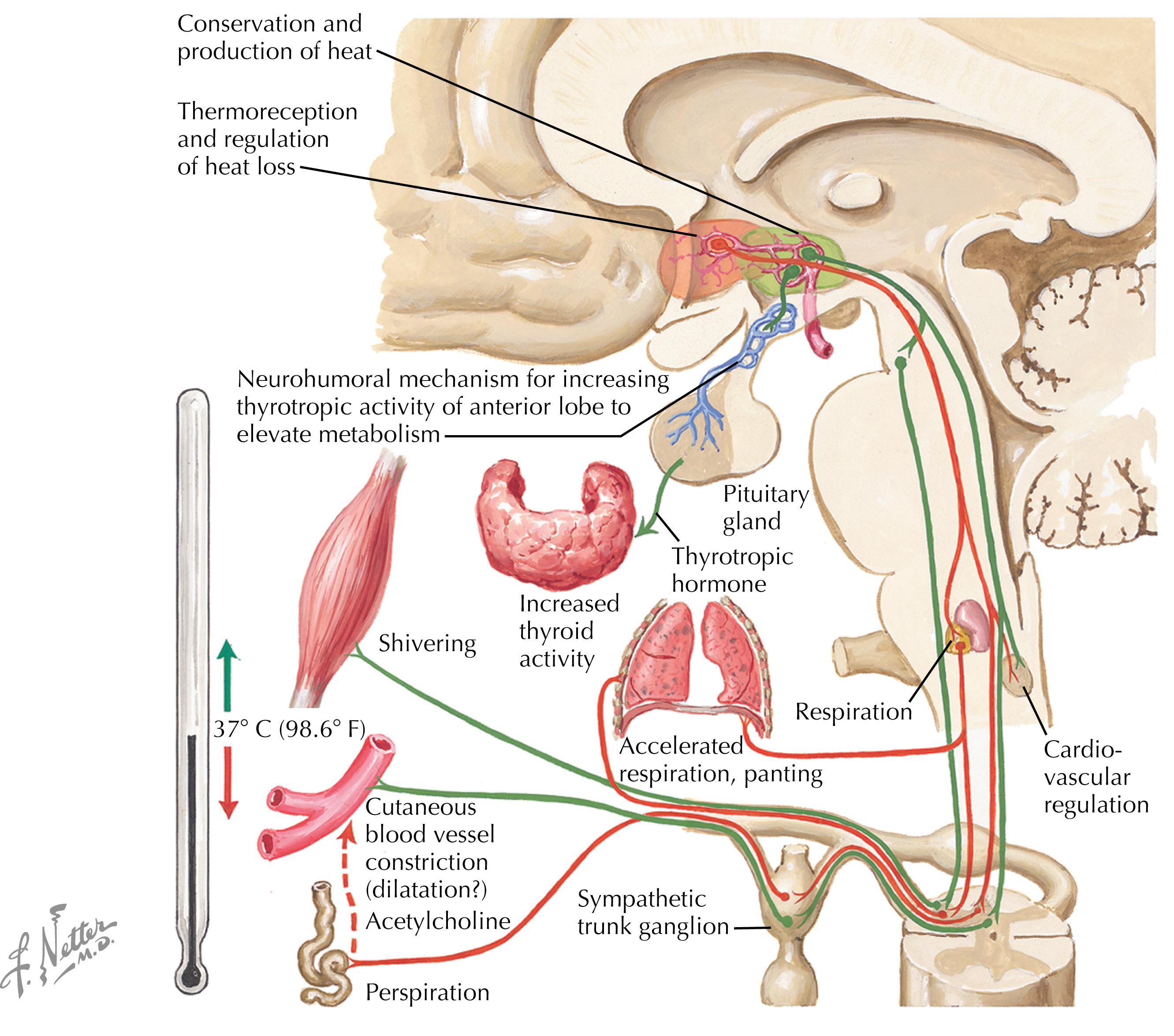Physical Address
304 North Cardinal St.
Dorchester Center, MA 02124
The body utilizes energy in the form of energy-rich chemical compounds to maintain normal function ( Fig. 21.1 ) and is inefficient; most reactions produce heat.

Sources of nonexercising heat production include involuntary smooth muscle contraction, myocardial contraction, muscle group contraction to maintain posture, shivering, digestion, and cellular metabolism.
Increases to 15–20 times the resting rate because of increased muscular contraction and cellular metabolism.
At maximum exercise, the body’s work efficiency is only 15%–30%; thus, 70%–85% of muscle energy consumption is converted to heat and must be dissipated.
The thermoregulatory system cannot maintain a homeostatic environment when heat production is increased beyond the body’s ability to transfer heat, resulting in an elevated core temperature.
Even at rest, thermoregulation requires complex interactions among the central nervous system (CNS), cardiovascular system, and integumentary system to maintain a core body temperature of approximately 98.6°F (37°C).
The CNS temperature regulatory center is located in the hypothalamus.
Increases in core temperature are sensed and centrally regulated by thermal detectors in the hypothalamus, which then provide stimulus via the sympathetic nervous system to initiate sweating and increased peripheral blood flow ( Fig. 21.2 ).

Core body temperature is determined by the net balance of metabolic heat production and heat exchange to and from the surrounding environment. Core temperature change can be defined in the heat balance equation described here ( Eq. 21.1 ).
S = amount of stored heat
M = metabolic heat production
E = evaporative heat loss
R = radiant heat loss or gain
C = convection heat loss or gain
K = conductive heat loss or gain
Heat loss can be divided into:
Nonevaporative heat loss
Evaporative heat loss
Nonevaporative heat loss dissipates most body heat when the ambient temperature is below 68°F (20°C).
A warmer body in direct contact with a colder body will result in heat transfer to the colder body.
Fourier’s law: the rate of conductive heat loss is directly dependent on the size of the contact area, thermal conductivity of materials, and temperature difference between materials and is indirectly related to material thickness.
Convection heat loss is heat transfer resulting from forced fluid flow across a warmer, relatively stationary surface.
Newton’s law of cooling: the rate of heat transferred is directly related to the difference between an object’s temperature and that of its surroundings.
Every object has a convective heat transfer coefficient (k)
The heat transfer coefficient (k) of water is 50–100 times greater than that of air.
Blood has a slightly higher k than water (i.e., relatively large amount of heat energy is transported with only a moderate increase in temperature of blood).
When the difference between the temperature of blood and that of the tissue through which it flows is significant, convective heat transfer will occur, altering the temperature of both the tissue and blood and follows Pennes’s model (1948).
Convective heat transfer depends on the rate of tissue perfusion of blood and the “local” vascular anatomy.
Convective heat loss is directly related to:
Amount of body surface exposed to circulating air
Speed of circulating air in contact with skin
Cutaneous blood flow (transferring heat) rate through dilated peripheral vessels at the skin surface
Convective heat loss is inversely related to the skin’s thickness between the peripheral veins and skin surface.
Convective heat loss is the primary principle guiding the use of cold-water immersion (CWI) for individuals being treated for hyperthermia.
Radiation heat loss occurs via the transfer of electromagnetic waves when energy (heat) flows from high temperature to low temperature.
Evaporation accounts for most heat loss when the temperature is above 68°F (20°C).
Heat is transferred through the evaporation of sweat and respiratory moisture.
Insensate respiratory loss of moisture equals 600 mL per day.
Become a Clinical Tree membership for Full access and enjoy Unlimited articles
If you are a member. Log in here